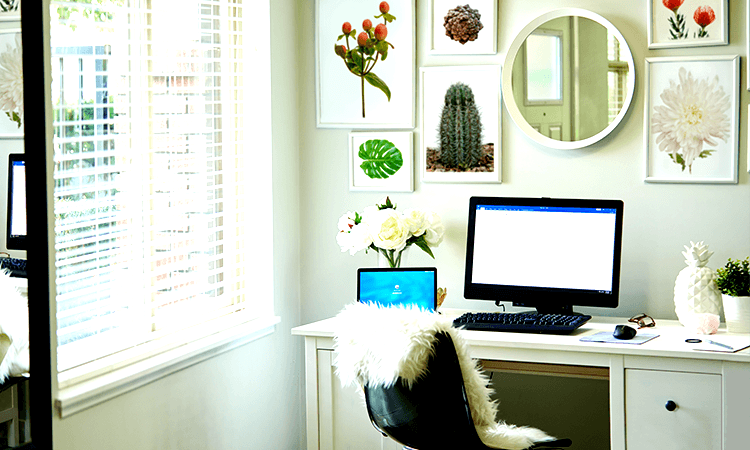Working from home has a long list of benefits, but one that’s often overlooked is the ability to design your own home workspace. Think about it: you have the power to create an environment that best serves your productivity. You can customize your furniture, ergonomics, decor, and more.
As more and more people embrace the future of working from home, understanding the benefits of a custom home workspace are important. Creating an ideal home workspace involves many factors. If you’re not sure where to start or are looking for improvements in your current space, follow these checklists to make sure your environment is working for you.
Home Workspace Checklists

Function
When you’re thinking about where your home office should be and what should be in it, opt for function over comfort. While your bed may be an enticing spot to spend the day in, you should instead select a space where you’re less likely to be distracted. Here are a few things to keep in mind:
- I have chosen a location that is functional and isn’t in the main activity area of my house or apartment, like the kitchen.
- Everything I need (my phone, documents, etc.) is easily in reach.
- I have removed distractions from my space (like my TV, for example).
If you take these items into account initially, it will be easier to set boundaries around your working time and not be interrupted by distractions.
Ergonomics
Ergonomics refers to the design and arrangement of things in a way that is most efficient and safe for the person interacting with them. When setting up your desk and devices, you should keep ergonomics in mind. Your workstation should allow your body to rest in neutral postures that support your back, head, and neck. Follow this ergonomic checklist when setting up your desk, chair, keyboard, and monitor:
- I’m facing forward and don’t need to twist my body to see my laptop or monitor.
- My torso is positioned vertically, and my head and neck are aligned with my torso.
- My shoulders are relaxed and not elevated.
- My elbows are close to my body, not extended.
- My forearms and thighs are parallel to the floor.
- My mouse and keyboard are on the same level and aligned with the midline of my body.
- I can easily reach my mouse, which fits in the shape of my hand perfectly.
- My monitor is at eye level and I can read my screen without bending my neck or twisting my body.
- My monitor is at arm’s length, or about 20 inches (50 centimeters) away.
- My monitor brightness and contrast have been adjusted for my comfort and there is no glare on the screen.
There are a lot of ergonomic factors to keep in mind, but paying attention to these from the start will pay off in the long-term for your body’s comfort.
Furniture
The furniture you select should ideally do two things: support the ergonomic factors mentioned above, and provide a pleasing aesthetic (although if you can only choose one, go for the ergonomics!). Bland pieces that are boring to look at could lead to a lack of motivation, so be careful when picking items. Here are a few factors to consider:
- My chair provides lumbar support for my back and is cushioned.
- My chair meets my ergonomic needs. (Ideally, it’s adjustable.)
- My furniture is fun or interesting to look at.
- I have reduced clutter in my space and kept furniture minimal.
- I have explored desk options (such as a standing desk) and chosen the one that works best for me.
- My desk is in a power position (i.e., facing the door) so I can see who is coming in and out of the room.
If you’re on a budget, look for inexpensive pieces at garage or estate sales; also explore discount shops for used furniture. If you can invest in one piece, spring for a high-quality office chair above anything else. Having a chair that doesn’t support your posture properly can lead to long-term back and neck issues. Adjustable chairs are ideal.
Decor
You may think that office decor should be your last priority when working from home. But studies have shown that even small accents can keep your mind refreshed and more productive. This checklist provides a few ideas for creating a dynamic, interesting space:
- I have personalized my space with items like pictures and small trinkets. (Tip: Rotate these items out every few months to refresh your space.)
- I have added color accents to my space. (Experts say blues and greens will inspire you to be more productive, but even just a pop of color can help liven up a space.)
- I have greenery around me. (Plants have been proven to make people happier!)
- I have natural lighting as well as overhead lighting or a desk lamp.
- I have hidden things I don’t want to look at, like cords or my printer.
You know yourself best when it comes to what you find aesthetically pleasing. Our number one tip? Make the effort to customize your space from the start. You’ll find yourself more mentally engaged in the work you’re doing, and in a more pleasant mood while doing it.
Final thought
No matter what kind of home workspace you have to work with, put your best effort forward in making it your own. Many of these suggestions can be done in small spaces and on a low budget and will go a long way toward helping you relax and stay refreshed throughout your workday. Creating an ideal ambiance for your home workspace work life can boost your mood and enhance your productivity, and both of these are critical to a successful work experience.



